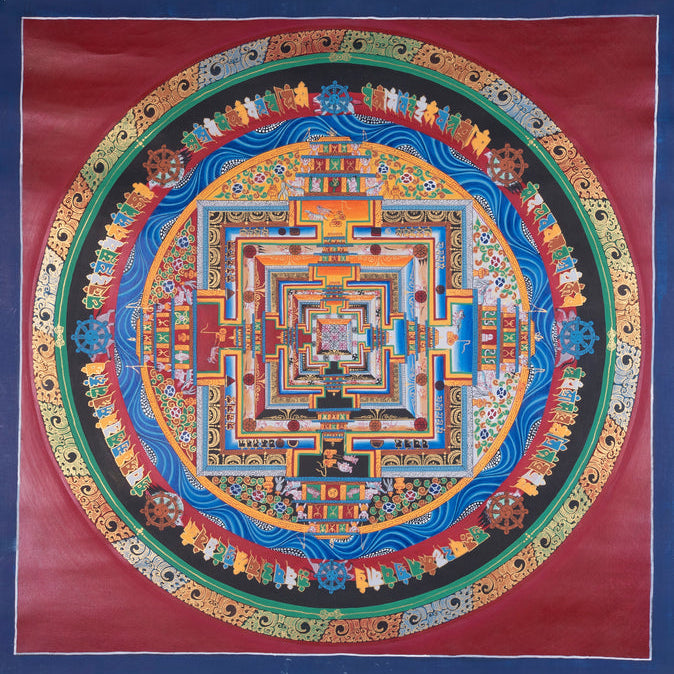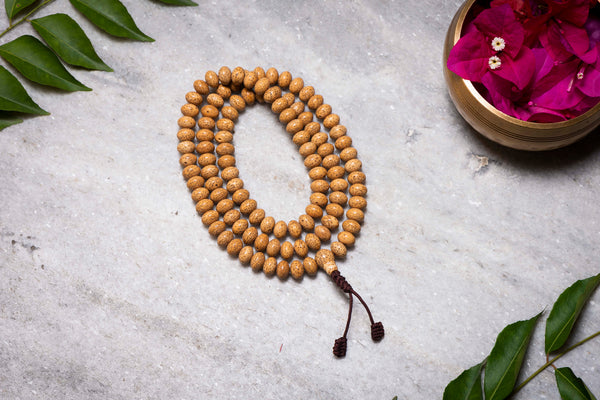Kalachakra Mandala: A Sacred Wheel of Time and Transformation
Posted by ABISHEK SHRESTHA

Kalachakra (which means “Wheel of Time” in Sanskrit) is a richly energetic tantra system in Vajrayana Buddhism. Kalachakra is the title given to a specific sacred teaching (tantra) and a main deity (yidam), and delves into the intimate relationship between the universe at large, the human body, and spiritual practice itself. Time and reality are seen as cycles by the Kalachakra Tantra, illustrating how external cosmic cycles are reflected in and reflect inner bodily patterns and contemplative practices.
Visual Structure and Symbolism of the Mandala
The Kalachakra Mandala is a richly symbolic diagram of the universe in Tibetan Buddhism. A five-storey palace is formed with intricate geometry—outer wheels composed of fire, vajras, and lotus petals for wisdom, indestructibility, and purity. Four glorious gates within open into the palace and represent the Four Noble Truths and enlightened activity. The inner sections of the mandala are the three realms of becoming (Desire, Form, Formless) and the three Buddha-bodies (Nirmāṇakāya, Sambhogakāya, Dharmakāyas). Together they house a total of 722 deities around Kalachakra and his shakti Vishvamata, a synthesis of compassion and wisdom. The geometry of the mandala—squares within circles—contains cosmic order and the dynamic cycles of time. Each color and detail used is rich with spiritual reference, aimed at moving the person from mundane perception to enlightened consciousness.
Body Mandala (Ground Floor): Includes physical body and material world (Rūpakāya), with 536 deities and profound astral symbolism, such as moon cycles and breath patterns.
Speech Mandala (Second Floor): Represents enlightened speech (Sambhogakāya), with 116 deities among which 80 Yoginis embody the noble qualities of the Buddha.
Mind Mandala (Third Floor): Aparanaprakrita Charya or coarser mind operations and the gateway to finer states.
Exalted Wisdom Mandala (Fourth Floor): This represents the subtle mind in which eight pairs of Tathāgatas reside in meditation presence.
Topmost Great Bliss Mandala: Centered within is a green lotus upon which Kalachakra and consort Vishvamata live in union with eight Shaktis attending to them—embodiments of the unification of bliss and emptiness.
The geometry itself is highly symbolic and founded upon the relationship between squares and circles. The square palace represents the orderly universe—its four directions and its constituents—while the circles that surround it represent the boundless wheel-like motion of space and time. This synthesis is reflective of the meaning behind the name itself: the “Wheel of Time.”
Although occasionally depicted riding atop Mount Meru, the cosmic axis of mythology, this is usually suggested rather than depicted in Kalachakra art. Every color within the mandala is highly significant:
Blue – wisdom of space/emptiness
Red – dynamic vitality and awareness
White – peaceful light
Yellow – soil and fertility
Green – activity and karma
Both together form a visionary chart of awakened reality. Meditation with the Kalachakra Mandala is meant to illuminate the mind—guiding the meditant from the wheel of samsara into the experience of nirvana.
Shambhala, King Suchandra, and the Buddha’s Transmission of Kalachakra
The Kalachakra Mandala is also identified with the myth of Shambhala, a spiritual kingdom located beyond the Himalayas. According to Buddhist mythology, King Suchandra of Shambhala traveled—under mysterious auspices—back to India's Dhanyakataka Stupa to commission a teaching that might allow him to proceed with the Dharma but not relinquish the concerns of the world. The Buddha displayed the Kalachakra Mandala and gave the full Kalachakra Tantra, an unprecedented system of time, cosmology, and inner enlightenment. King Suchandra wrote it into a 12,000 verse root text and brought it back to Shambhala, from where he and six later successors—Seven Dharma Kings—spread the teachings. There ensued a dynasty of successive Kalki Kings numbering 25, who began with King Yashas and unified the Shambhala under a unified Kalachakra while watching over its preservation as a utopian world-Dharma.
An influential prediction in the Kalachakra tradition foresees that at a very distant time period (ca. 2424 CE), the world will sink into chaos and spiritual degeneration. Thereafter the 25th Kalki King Rudra Chakrin will appear out of Shambhala with an enlightened army to defeat the forces of ignorance and once again establish world harmony. The individuals who have been granted the Kalachakra initiation in past lives or the current one are reborn to assist during this rebirth. With practitioners, the Kalachakra Mandala is not only a vehicle for transformative meditation but a living connection with this mystical mythology—where time is not linear but wheel-like and enlightenment is individual and cosmic as well. Tibetan masters remind us therefore: to find Shambhala you have to journey inward.






